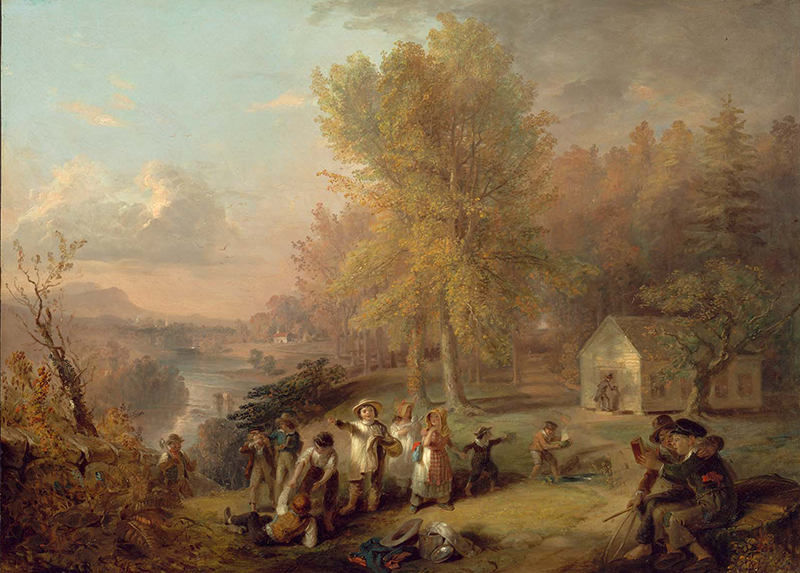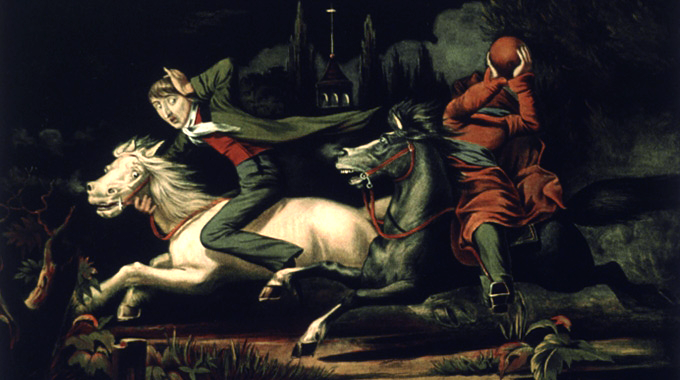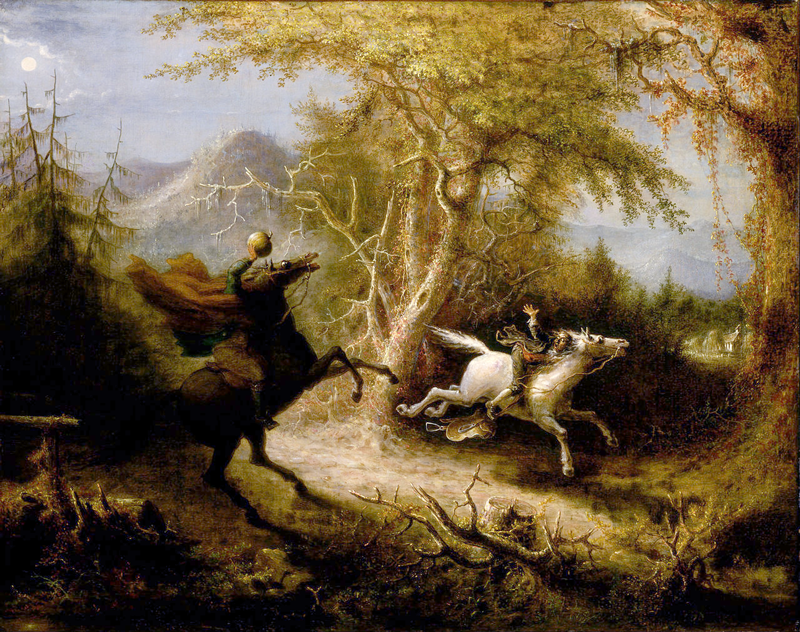If Christmas is the great holiday for sounds — think of all of the masterworks and the centuries of carols — then surely Halloween is the bushel holiday harvest for sights. The very plumage of the landscape itself morphs from pastel verdure to vermillion explosions of the sorts of colors that we think of as having tongues, lapping across expanses as if summoning your gaze. The boogeymen come out, too, much as the ghosts do at Christmas, but whereas the latter have a subtle ease to them, the Halloween haunts rarely do. Part of that may have to do with Washington Irving and his Sketch Book of Geoffrey Crayon from 1820, a work that, in one vignette, helped inspire a visual schema that still colors the season.
Most people don’t read the Sketch Book in full anymore, focusing instead on its two most famous tales: “Rip Van Winkle” and, of course, the object of our purpose, “The Legend of Sleepy Hollow.” These are bumper crop works that repay and repay, but that’s the gist of the thirty-four essays, stories, anecdotes, and musings that comprise the Sketch Book itself, a weird piece of Americana by turns folksy, Gothic, chatty, and terrifying which also happens to be exceedingly accessible. And, wouldn’t you know, entirely modern, as if Irving’s words have piggy-backed atop the Horseman’s mount and rode into the latest age, ready to gallop off with a willing reader.
I return to at least “The Legend of Sleepy Hollow” every Halloween. We all know the story: The somewhat vain new schoolteacher, Ichabod Crane, arrives in the village of Tarry Town in New York to take up his post, climb some social ladders, and cadge a number of free meals in the process. He falls for one Katrina Van Tassel and is fronted with a rival for her affections, the brawny Brom Bones. There’s a harvest dance at the Van Tassel residence where scary stories are told, including one of a dead Hessian whose shoulders represent the highest point of him, who patrols the glen in search of a replacement head. The skinny is that this demon rider can’t go past the bridge, so the key is in getting there. Ichabod and his plow horse head home late at night, a monstrous rider appears, a chase ensues, a fiery pumpkin is launched, and poof, there goes the schoolteacher. Cooler heads — ha — conclude he was a broken man and left in the night, but as Irving implies, the true townies knew the truth. Hessian monster gonna get you, in other words.
I love Irving’s prose: I love the narrative, the combined rustic charm and apprehension, but what brings me back yearly is the story’s visual aplomb. It reads, as much as any work I have ever read, like a painting taking on prose form. The reader is all but placed in these hillocks and cart-worn back paths where pheasants poke out their heads and the latest sound of the latest cricket has you looking amongst a pile of leaves to see if that was a bug or something else. That sense of the visual is so strong that its allure and festive shadings render what ought to be an outright terror tale as something more pleasingly conspiratorial. We pass along the knowledge that sometimes being scared can be fun, especially if it is autumn, and especially if you are in the northeast, where being scared at Halloweentime often means having a good imagination — something we should all cultivate and celebrate.

Fittingly, pictorial artists picked up on the visual possibilities of what they might make from Irving’s most famous tale, and three works in particular are worth consideration as the cider is readied. There is first Henry Inman’s 1845 painting Dismissal of School on an October Afternoon, which could double as a multi-hued preface for both Ichabod Crane’s big night out and the very joys of the season itself. That expectancy, the thrill of waiting on the unknown, seems to come when the air first acquires that smell of smoke every year.
Inman was best known as a portrait painter, and this painting is from the year before his death, in his early forties. The center-ground children possess a cherubicness not out of line with religious portraiture, but note how the burnished world explodes around them as if they were being subsumed by a cornucopia of flora. Everything teems, including possibility. So it goes for children, and so too it goes for our schoolteacher, who locks up his classroom in the background. “I. Crane” is inscribed over the door, and a path strewn with leaves leading into the woods is at his left — the adult’s passway into the woods, away from games of youth. So it goes. But the landscape is so invigorating that one senses the pedagogue to be imbued by its charms as well. We are all ageless here, bound only by what our fancies won’t allow us to fancy: Something which never troubled Schoolmaster Crane once he came to Tarry Town.

Of course, there is also the matter of his demise (or his disappearance, whichever you choose to believe). William John Wilgus’s 1856 chromolithograph Ichabod Crane, Respectfully Dedicated to Washington Irving, presents an almost matronly headless Hessian, all robes and folds. Billowy. Even bossomy. In the story, Ichabod’s intention was to secure the hand of his beloved at the harvest dance, which didn’t quite work out, as these things sometimes go. He enters the hollow heartbroken, and it’s that idea that Wilgus is playing off of, expanding a tale of a ghoul into a tale of romantic pain, which is its own make of ghoul. This hard-driving Ichabod uses his hand to block his ear — a case of, I cannot bear to hear more — while the apparition uses both hands to hold its strangely smooth pumpkin aloft, as if it is about to dash the thing, as hopes have just been dashed. Ichabod’s other hand all but chokes his horse at its throat. He doesn’t even use the reins. Flight and desperation rarely ride so plainly together.
But we need a payoff painting, a work that Irving himself could have stood before and uttered, yes, that is what I was doing. Actually, he may have, as he was friends with John Quidor, the artist responsible for 1858’s The Headless Horseman Pursuing Ichabod Crane. Quidor had a curious backstory. Apprenticed, he essentially sued his master for neglecting his progress as an artist and then, later in life, was said to have neglected his own students and fallen asleep when he was meant to be dispensing information. Perhaps he was prone to the languorous daydreams we see from Ichabod in the 1949 Disney cartoon. He had been a fairly rococo painter, and one who favored a huge palette, until his later period, when he’d do works like this one. Gone are the over-bright flourishes, and instead we find something more born of the earth, as if colors have been sourced from inside of it.

This Ichabod — who looks scarier than most monsters storming out of hell — is literally encircled in blackness. The blackness of the womb, the blackness of the abyss, the blackness in turn lit up by, of all things, a fearful shade. That idea of black upon black leading to light is not a comforting one, but we can be tasked with much in this life, and perhaps that color scheme/progression is a metaphor for necessary internal growth. The leaves in the trees look utterly becalmed, which provides another jostling effect. You want to see them shake and sway, but the landscape has a kind of complicity in watching the scene play out. Just as we as viewers, and as readers, do.
In the Quidor painting, there is no bridge that Ichabod is going to get to. The Horseman is taking careful aim. You don’t even have the sense that our lad, loosed from love, ever even had a shot at reaching the bridge. And so the painting itself serves the function of connecting viewer, demon, pedagogue, season, and story in one impressive span. But still — probably best to duck. And keep riding. •




